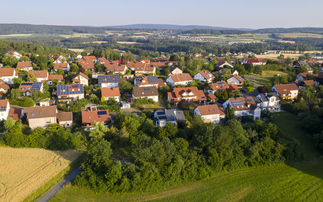Richard Black argues that the national climate action plans submitted to the UN represent good news for the global renewables industry
As will be well known to anyone within shouting distance of the UN climate summit, the carbon-cutting pledges governments have sent in to the UN climate convention won't be enough to keep global warming below the 2 Celsius ceiling to which all countries are now, officially, committed.
But there's another very pertinent question to ask about the INDCs, as they're known, that has been less discussed: What might they do for renewable energy?
Affordable, accessible, sustainable energy is something that's much in demand. The UN Secretary-General has a special initiative on it, and it's been mentioned in speeches here by a number of developing world leaders including India's Prime Minister Narendra Modi.
And as the International Energy Agency said in its recent report for Africa, renewables hold the key, certainly in rural areas, where they do away with the traditional (and largely absent) infrastructure of power lines and sub-stations.
The more renewables get built, the cheaper they become. So the INDCs question is actually key to all three elements of the energy 'trilemma' - cost, decarbonisation, and security of supply where supply now exists or availability of supply where it doesn't.
For the UN summit, my think-tank, the Energy and Climate Intelligence Unit, together with the US-based Climate Nexus, compiled a report aiming to calculate the impact of the INDCs on renewables expansion.
It's not a straightforward question, for a few reasons.
Firstly, whereas some INDCs put forward numerical targets for renewables, many do not. And even those that do may contain other components such as a decarbonisation target that hint at a bigger eventual level of renewables penetration.
Secondly, some INDCs talk of 'clean energy' or 'non-fossil fuels', which obviously leaves open the question of how much share nuclear power might take, or transport biofuels, or whatever.
Thirdly, most developing countries express their decarbonisation ambitions in terms of decreasing carbon intensity or decreasing emissions against a business-as-usual trajectory - both of which mean that the extent of eventual clean energy capacity built will depend both on how efficiently energy is used in future and on how fast the economy grows.

Fourthly, some INDCs from developing countries will be implemented only if adequate financial support materialises from Western nations.
OK, that's quite enough excuses on the page already for not giving you a straight answer.
On capacity, we calculate that China and India between them will build more wind and solar capacity between now and 2030 (633.5GW) than exists in the world now (548GW).
These figures take us way above the straightforward renewable capacity targets of the two Asian giants, which add up to about 400GW by the early 2020s; so we can see that the INDCs do themselves extend ambition.
Both wind and solar are coming down in price as they get built - what scholars of industry term 'experience learning'. For solar, module prices fall by 20 per cent for every doubling of capacity (with similar, but less easily calculated, falls in supply chain and installation costs). Production volume expanded 30-fold in the decade from 2000; you can do the maths yourself on the cost reduction.
Our estimates are conservative compared with some other estimates. China's National Centre for Climate Change Strategy estimates that China alone will see 345GW of wind capacity and 325GW of solar installed by 2030.
We can also throw into the mix the World Resource Institute's conclusion that the INDCs of the eight biggest emitters - Brazil, China, the EU, India, Indonesia, Japan, Mexico and the US - will produce a doubling in their overall renewables capacity by 2030.
We didn't look at other renewables such as hydro, geothermal and biomass, for a number of reasons. They're all mature, so price falls wouldn't be expected; geothermal and hydro potential have been well mapped and, to a large extent, tapped; and for both biomass and hydro, there are concerns about expansion in the face of competing demands for land and water.
Offshore wind too we left out of the equation - it's new enough as to make the experience learning effect hard to estimate accurately.
Even so, these are impressive numbers. Although as one journalist observed at our news conference in COP21, countries will also need to think more about transmission, distribution and balancing as they increase the amount of intermittent renewables on their grids.
Nevertheless, it's reasonable I think to project three important conclusions: INDC implementation will bring down the cost of solar alone by a further 20 per cent at the very least, and probably a fair bit more; many more villages will be supplied with electricity than are now; and the traditional utility model based on block power stations will be even further under assault.
For comparison, we also looked at what's happening to prices for new-build nuclear electricity. It's not easy: data is impossible to come by in many parts of the world - added to which, as The Economist recently noted, there is virtually no nuclear new build in OECD countries.
So we looked at what we could - namely, cost projections made over the years in the UK for building the long-awaited ‘first nuclear power station since 1995'. Essentially, cost projections have doubled since 2005-8. France is seeing a similar trend.
The other thing that we couldn't model is, of course, innovation. No-one, not even Greenpeace, predicted the rapid price falls and consequent expansion of solar power. Equally, I wouldn't rely now on any of the predictions for storage or electric vehicles.
However... the final point to mention is that the full potential of wind and solar will only be achieved if there is a deal here. Without that, the finance that countries such as India, Bangladesh and Indonesia need to implement their INDCs fully may well not materialise; and markets will not receive a strong signal on the low-carbon direction of travel that will accelerate low-carbon investment to its fullest extent.
If there is a deal, how far and how fast will renewable capacity expand from its current 548GW? To coin a phrase; the sky would appear to be the limit.
Richard Black is director of the European Climate Intelligence Unit (ECIU)
This article is part of BusinessGreen's Road to Paris hub, hosted in association with PwC.








